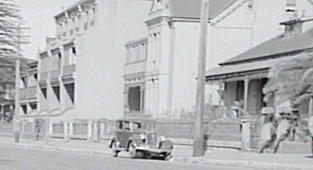The Lumière film Patineur grotesque
During the 1990s a project to find copies of, catalogue, and document all films produced by the Lumière company of Lyon, France was undertaken by le Centre national de la Cinématographie (now le Centre national du cinéma et de l'image animée) (CNC), l'Université Lumière-Lyon 2, and la Bibliothèque du Film in France. The result of this effort was the publication in 1996 of a major reference work, La production cinématographique des frères Lumière.1 Much of the material in this book has since been made available online.
One discovery during this research was that the film Patineur grotesque (or The Humorous Roller-Skater), which has number 117 in the original Lumière catalogue and number 73 in the new catalogue, had been taken in Australia.2 But prior to this time, no reference to the film was known of in any Australian document. A copy of the film was subsequently acquired by the National Film and Sound Archive of Australia (NFSA).
This film is the earliest surviving motion picture taken in Australia, and may be the earliest motion picture ever taken in Australia.
It can be viewed here. It shows the antics of a somewhat rotund (perhaps from artificial padding), comic roller-skater, wearing shabby clothes and smoking a large cigar, who merrily falls about dropping and trying to retrieve his hat and dizzyingly spinning around on his skates. He also shows off a pale-coloured image of a hand on the seat of his pants to the spectators and the camera. The field of view is fixed – there is no panning, tilting, or zooming – and the scene, shot in one take, lasts about 53 seconds.
Various details of the film are addressed below.
Where was it filmed?
The film was shot in Prince Alfred Park, Sydney, just south of Central Railway Station (then known as Redfern Railway Terminus). The camera was pointing slightly to the west of south.
| Below is a copy of a frame from the film.3 | The image4 below is a view in almost the same direction taken from a point not far to the left (east) of where the skater in the film performed. |
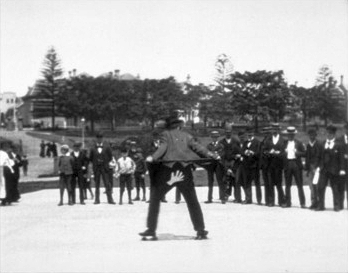
Image courtesy of Association frères Lumière
| 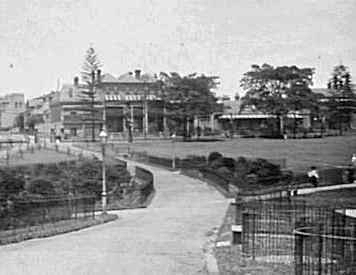
Image courtesy of City of Sydney Archives
|
The street that runs across the background of the scene is Cleveland St, and the street that is effectively the continuation of the path up the slope on the left is Pitt St, Redfern.
| In the 1892 plan5 on the right,
assuming the paths are accurately represented, the skater's position would have been
below the "a" in "Park" and the camera on or near the "r" in "Alfred", approximately.
| 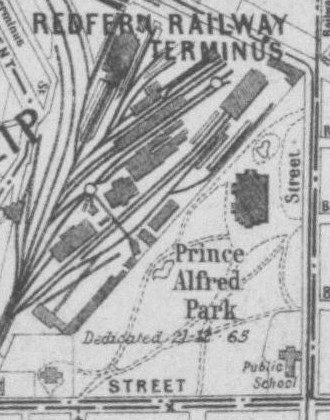
Image courtesy of the National Library of Australia
|
When was it filmed?
Analysis8 of the lengths of shadows seen in the film indicates that the filming took place almost certainly late in September or early in October 1896. Public exhibitions of the cinématographe in Sydney did not commence until 28 September, so prior to then any day would have been a possibility for filming. After this date the only day of the week when the cinématographe was not being used for exhibitions was Sunday, so possible dates of filming in this period are 4 and 11 October. Almost no traffic is seen on Cleveland Street in the background: is this because the film was taken on a Sunday? Unfortunately there is nothing else available to make a comparison between street activity on different days of the week.
One possibility is that the film was taken soon after Sestier arrived in Australia and before any consideration was given to processing films there. A week after he reached Sydney he received a cable from the Lumières telling him that the film(s) he had shot in India and sent back to France had had their packaging opened by customs officials (and presumably were thus useless).9 Sestier would probably have wanted to prove to the Lumières that he could take films, and thus to have shot one as soon as practicable, in late September 1896, and sent the exposed negative to France straight away – this time appropriately packaged (and labelled). And if this is the case, then Patineur grotesque is the first motion picture filmed in Australia.
Otherwise, it could have been taken early in October 1896, when Sestier made other motion pictures in Sydney.
The time of day of filming was close to midday: the camera was pointing approximately south and so were the shadows, so the direction of the Sun was roughly north.
Who filmed it?
The cinematographer was almost certainly Marius Sestier, and this was the first or one of the first films he took in Australia to send to the Lumière office in Lyon, France.
Who was the skater?
One very strong possibility is that he was Fred Norris,
who was born c. 1865 in Ohio, USA and went to Australia in 1889.
At the end of that year he appeared at the Haymarket Theatre, Sydney,
where he was billed as the world's champion skater
;
late in 1890 he was at the Coogee Palace Aquarium, Sydney,
and was announced as America's champion burlesque skater
or America's greatest burlesque skater
.
During the 1890s he performed at various venues in Australia and New Zealand,
and in early October 1896 he was in Sydney and on the programmes at Coogee
Palace Aquarium and Bondi Aquarium.
Early in 1895 he appeared with Woodloch's Circus in Sydney, the report of the first show stating
F. Norris did some comic skating, which evoked much merriment, principally on account of the grotesque attitudes which the performer had necessarily to adopt.10
Two later reviews of his performances give further details of his stage behaviour. In July 1902:
The Temperance-hall was crowded in all parts on Saturday night, when the above-named company gave another entire change of programme, in which Professor Fred. Norris, the "skatorial king," made his first appearance in Hobart. He introduces his act, dressed as a tramp, and imitates a novice on roller skates, and his ludicrous antics created the heartiest laughter. At the conclusion of his act, Professor Norris gave a wonderful exhibition of fancy skating, and performed most difficult feats, despite the limited stage room.11And in February 1904:
.. and accordingly Fred. Norris came on, and in his inimitable manner fell off his skates.12
Whoever the skater was,
did he perform for free or was he given some form of remuneration for being filmed?
The only reference to the film in Sestier's accounts book13
is to a cost of 8 shillings for the film material of Skater
(spelt in English, interestingly);
as this amount is comparable to (though less than) the listed costs of other films
it must mean that the skater was not paid for his efforts.
And this may well account for his moving out of the field of view
for the last 10 % or so of the film!
When was the film first shown publicly?
The bi-weekly newspaper of Lyon, France, La Construction Lyonnaise, lists the film in its 1 April 1897 edition (p.83b, Spectacles) with a plural title: Patineurs grotesques. On 4 April 1897 in the weekly newspaper Le Passe-Temps et le Parterre Réunis (p.8c, La Photographie Vivante par le Cinématographe "Lumière") its title is singular. The columns name films showing for the week at the Lumière "cinema" in Lyon. The lists in both papers are of the same films, though there are other minor differences in some titles. (Other Lyon newspapers at this time might carry reviews.)
To muddy the waters, in the 1 March 1897 edition of La Construction Lyonnaise and the 7 March edition of Le Passe-Temps ... there are listed Melbourne: Patineurs comiques. Another Lyon paper, Lyon républicain, reviewed this film in its edition of 28 February 1897; this review is quoted in La production cinématographique des frères Lumière:
«Enfin une scène de patineurs comiques, prise à Melbourne, qui nous fait assister à d'amusants exercices exécutés par des virtuoses d'une rare agilité.»But both this film's title and the review refer to more than one skater, so the film can't be what we know as Patineur grotesque. Was the attribution "Melbourne" added because the film was (thought to have been) shot in or sent from Melbourne? And what became of Patineurs comiques? Was it the film Patineurs au Parc central, Lumière catalogue number 327, taken by Alexandre Promio in New York? Other films from the United States were shown at the Lyon "cinema" at about the same time that Patineur grotesque was shown. Or was Patineurs comiques yet another film, maybe also shot in Australia, and now lost? Or was it indeed Patineur grotesque with an erroneous title and bad or false review?
When was the film first shown in Australia?
So far no evidence has come to light that the film was shown in Australia during the time that Marius Sestier was in the country (16 September 1896 – 19 May 1897). Nor is there any evidence that the negative was developed or a print made there.
However, from 1 May 1897, Lumière cinématographes and films became available on the open market worldwide,14 and any showman could obtain them to show as he wished. And because Patineur grotesque is listed in the first published catalogue of Lumière films (as number 117), it was available for screening from before the date on which Sestier departed.
From mid-June 1897, William Pursehouse and J. Pettitt took a travelling show around Queensland and New South Wales, featuring a Lumière cinématographe with Lumière films, an Edison phonograph, and musical items. And one of the films that is listed in their advertisements is called Comic skating act.15 Pursehouse himself, some years earlier, had been a fancy skater, and was likely enough intrigued by the film's title in the catalogue to have obtained a copy. This film was almost certainly Patineur grotesque; the only other possibility for it, as a Lumière film, is Patineurs au Parc central, but this isn't "comic". Unfortunately, details of their shows are scant, and in reviews there is little given about the films they exhibited.
Other questions, and some comments
Was the filming of the skater arranged beforehand, or did the cameraman (almost certainly Sestier) simply happen to find him by chance? Equivalently, was the skater performing an arranged routine, or was he simply caught in the act? If the former, why was this particular location chosen? If the latter, why was Sestier in this part of town with his camera and associated equipment?
Why was it filmed where it was? Some factors that were probably influential are:
- the need for flat, smooth, hard ground on which the skater could perform;
- enough distance between the camera and the skater;
- few people to get in the way or to distract attention in the film;
- camera pointing – away from the Sun, and towards somewhere with little activity in the background.
When was the film sent from Australia to France? As noted above it was showing at Lyon on 1 April 1897 so obviously arrived before this date. Assuming it was sent on one of the steamers of the Compagnie des Messageries Maritimes (the French shipping company handling mails), the latest it could have been was the Armand Béhic, which left Sydney on 24 February 1897 and Melbourne on the 26th, and arrived at Marseille on 29 March. However, this was probably too late for the film to get through customs, be sent to Lyon (by train), and be processed and sent to the "cinema" by 1 April. The previous CMM ship was the Polynésien, which left Sydney on 27 January 1897 and Melbourne on the 29th, arriving at Marseille on 28 February. (A passenger on this voyage of the Polynésien was H. Walter Barnett; might he have hand-delivered the film to the Lumières in Lyon?)
Clearly the film could have been sent well before these dates, and likely would have been if Sestier wanted to get a sample of his film-taking to the Lumières as soon as possible. But this then raises the question of why did it take several months for Patineur grotesque to appear in the Lyon "cinema"? On the other hand, if it was not sent soon after it was shot, why did Sestier keep hold of it?
A crucial factor in the timing of the sending of the film is the exact date of completion for publication of the first list of Lumière films. As Patineur grotesque is on this list the film would have to have left Australia at least a month before this first edition was published. If this date, or even an approximation to it, can be ascertained then this should narrow the range of dates for when the film was despatched.
Was the undeveloped negative, the developed negative, or a finished print sent to France? This depends on when film processing facilities became available to Sestier, and thus on when the film left Australia.
Who gave the film its title?
It appears that the name Patineur grotesque was assigned by the Lumière company
in France, rather than by Sestier.
(Sestier even referred to it by the English word Skater
in his accounts book.)
Was H. Walter Barnett involved in the production of Patineur grotesque? This is unlikely ever to be known. But the earlier the film was shot (should the exact date be determined), the less likely that Sestier had met Barnett by that time.
Curiously, a laterally-reversed (i.e. mirror) image of a frame of the film is shown on page 302 of volume 1 of Georges Sadoul's Histoire Générale du Cinéma, misidentified as "Les joueurs de boule[s]".16
There are absurd claims that Patineur grotesque was made as an insult to someone, and that the reason it was not shown in Australia while Sestier was in the country is that he (Sestier) was afraid of potential legal repercussions.17 There is absolutely no evidence to support either of these assertions, nor any to even suggest their possibility.
References and notes
[1] Michelle Aubert and Jean-Claude Seguin, La production cinématographique des frères Lumière; la Bibliothèque du Film, Paris, 1996.
[2] How was this determination made?
[3] Patineur grotesque (Cat. Lumière N°117)
Opérateur : Marius Sestier
Australie, Sydney, 16 septembre 1896 – 22 janvier 1897
© Association frères Lumière
association.freres.lumiere@orange.fr
[4] Detail from City of Sydney Archives, NSCA: SRC687 (digitised copy on the Web): http://www3.photosau.com/cos/scripts/ExtSearch.asp?SearchTerm=026190.
It is extraordinarily fortuitous that this photograph of a somewhat dull scene became a "CHRISTMAS AND NEW YEARS GREETINGS" postcard that ended up in the collection of the City of Sydney Archives and that they put a digitised copy of it on the World Wide Web.
[5] Detail from digitised copy of a map held by the National Library of Australia: http://www.nla.gov.au/apps/cdview?pi=nla.map-rm1918-s3-a3-v.
[6] Detail from City of Sydney Archives, NSCA: SRC4596 (digitised copy on the Web): http://www3.photosau.com/cos/scripts/ExtSearch.asp?SearchTerm=031009.
[7] In October 2010 the park was still a park but was no longer laid out with fenced paths and lamps and flower-beds, and was mostly covered with grass. The Norfolk Island pines are gone, replaced with other trees along the border of the park. There is an avenue of mature trees running up the slope to Pitt St roughly along the line of the path seen in the film. Also, most of the houses in the background have trees in their front gardens. The result is, that from where the camera was positioned when the film was taken, little of the background streetscape can be seen.
[8] This analysis is imprecise and inaccurate because it is difficult to get fair measurements from the video clip of the film. The measurements (in pixels) were taken when the skater has his coat lifted, and are the length on the ground of the shadow of his coat and the height of the end of the coat from the ground.
On any particular day, the minimum value (which occurs at midday) of the ratio of the length of an object's shadow to the object's height is
| tan ( latitude - arcsin ( sin ( obliquity of the Ecliptic ) * sin ( Sun's position on Ecliptic ) ) ) |where the Sun's position on the Ecliptic is the angle around the Ecliptic measured from the Vernal equinox. The latitude of Sydney is nearly 33.9° south. (At Sydney at the summer solstice the nearest the Sun gets to the zenith is approximately 10.4° (to the north).)
The red line in the graph below shows the minimum shadow to height ratio (calculated from the above formula) for days from the start of September to the end of the following January. On any particular day at any time (during daylight) the value of this ratio will be equal to or greater than the value of the corresponding point on the red line. The three vertical green strips indicate the days when Sestier was in Sydney. The horizontal yellow strip indicates a range of values for the ratio determined from measurements of features in the film frames. The intersection of the red line with this strip shows that Patineur grotesque was almost certainly shot in late September or early October.
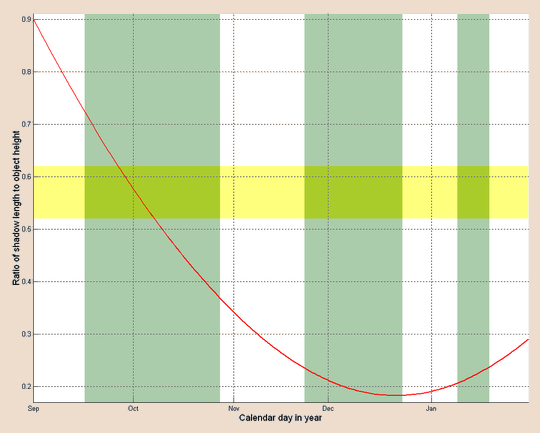
Graph showing minimum ratio of shadow length to height against day of year
[9] The text of the cable (received on
24 September 1896) is recorded in
Sestier's accounts book for his tour of India and Australia:
Sestier Telegraphe restant Sydney
Impossible empecher Négatif ouvert Douane Soignez Emballage
Lumière
The NFSA has a copy of the contents of this book as
Title no. 1467275: [MARIUS SESTIER COLLECTION] : [TOURNEE SESTIER : ACCOUNTS BOOK];
the relevant image file is note08.tif.
I am greatly indebted to Mme. Dominique Petitbois and M. Robert Sestier,
great-grandchildren of Marius Sestier, for allowing me to consult the copy of
this invaluable document.
[10] 17 January 1895, The Sydney Morning Herald, p.3f, Woodloch's Circus.
[11] 21 July 1902, The Mercury (Hobart, Tasmania), p.5d, Fuller's Entertainers.
[13] NFSA: title no. 1467275 (op. cit.), image file note22.tif.
[14] December 1896, The Photogram (UK), p.302a:
Trade
Novelties.
APPARATUS.
Lumiere's Kinematograph is now being sold in Great Britain, the Colonies, and
America, by Fuerst Bros. No apparatus can be delivered before May next.
20 January 1897, Australian Photographic Journal, p.7b:
Cinematographe Agency. – Fuerst Bros., of 17 Philpot Lane, E.C., [...].
[Cinematographes and films will be available from 1 May 1897]
[15]
[16] Georges Sadoul, Histoire Générale du Cinéma,
tome 1, L'invention du cinéma 1832 - 1897;
Denoël, 1973 (3rd edition).
The title given to the image on p.302 is (incorrectly) "Les joueurs de boule";
it is "Les joueurs de boules" in the book's index.
[17] The relevant article is too atrocious to merit a citation. My analysis of many of its problems is available here.
|
Copyright © 2010 – 2020 Tony Martin-Jones | FILM HISTORY INDEX |
Edition 3 (2020-07-16) [First edition in 2010-10] |
